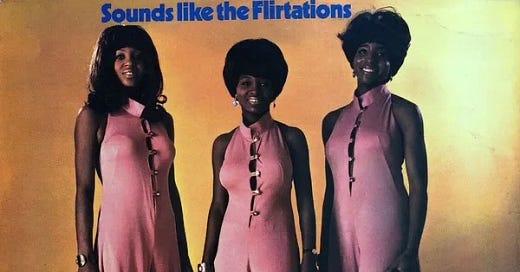Genre of the Day - Northern Soul
Album of the Day - Sounds Like The Flirtations by The Flirtations (1969)
April 28, 2024
Today’s genre name is so simple that I was completely shocked at its true origins. I was expecting an umbrella term for all of the soul music that came out of the northern United States: Detroit soul, Chicago soul (which we covered), Philly soul (also covered). But northern refers to a more far-flung north.
This is a genre sort of by and for music nerds, cratediggers just like me who in the 1960s who were obsessed with niche records. Those cratedigging soul music lovers were particularly concentrated in northern England. Around Manchester, those people began to bond and conglomerate centered around a particular record store—Soul City. The owner, Dave Grodin, started dubbing the niche records people sought out as ‘Northern’ soul to differentiate them from the more popular American soul records. This culminated in a tiny but powerful movement of all-night, dancing soul lovers addicted to soul records from tiny record labels mostly imitating the Motown sound. They favored swinging dance beats that resembled the peak of Motown’s popularity in the mid-‘60s rather than new sounds later in the decade: perfect for an early form of break dancing that people in Northern soul clubs were cooking up. What was going on in northern England in the ‘70s? How did people have all this energy?!
You never know how a particular sound will travel and not just become popular, but latch on somewhere new in a way the original sound only temporarily had before. Just a couple months ago in an early article on this column, I listened to a flavor of Memphis rap beloved by eastern European hip-hop heads called drift phonk. Perhaps more than drift phonk, though, the whole Northern soul ideology was of great benefit to those lesser known groups. The Flirtations—who actually just released an album this month that I’ll definitely check out after having written today’s article—were one. A trio à la The Supremes, they took a trip to London in 1967 in their early years as a group. They found that the crowd’s adoration stood head and shoulders above America and decided to make the UK home. Despite the success of the song “Nothing But A Heartache” on both sides of the Atlantic, they continued on in England and continued to become revered as the Northern Soul movement developed. Here they are dancing in Bath Abbey in a stunning mix of ‘60s mod glam soul and regal English edifices.
They fittingly notch the top spot on RYM’s Northern Soul chart, and for good reason. Lead singer Earnestine Pierce possesses a voice that easily matches the fire of her Yankeeland-bound counterparts, and she’s able to elevate the lyricism that doesn’t necessarily reach the heights of Holland-Dozier-Holland with ease. The lyrical themes hinge often on the hit Motown themes of yearning for a lover to stay and romantic insistency. On “How Can You Tell Me?” Pierce’s vocal and Shirley Pearce’s & Viola Billups’ harmonies particularly blossom with the romantically-stricken anger that underlies the best Motown girl group hits. The syncopated instrumental arrangements also work to be as elegant as their Detroit peers, often with success: there’s the sailing, drama-flushed strings of “Everybody Needs Somebody (To Love in the End)” and the big, hammy horns of “Nothing but a Heartache” to make it a lush, dynamic affair. I would be right there with Britons buying up this record in the 1960s. However, they never forget home or soul’s roots, with the song “South Carolina” longing for the state they left behind. Success is always a trade off, and they likely never thought their love for the Beatles would take them to the heights they reached in a completely foreign country. The magic of music ultimately knows no manmade border.




